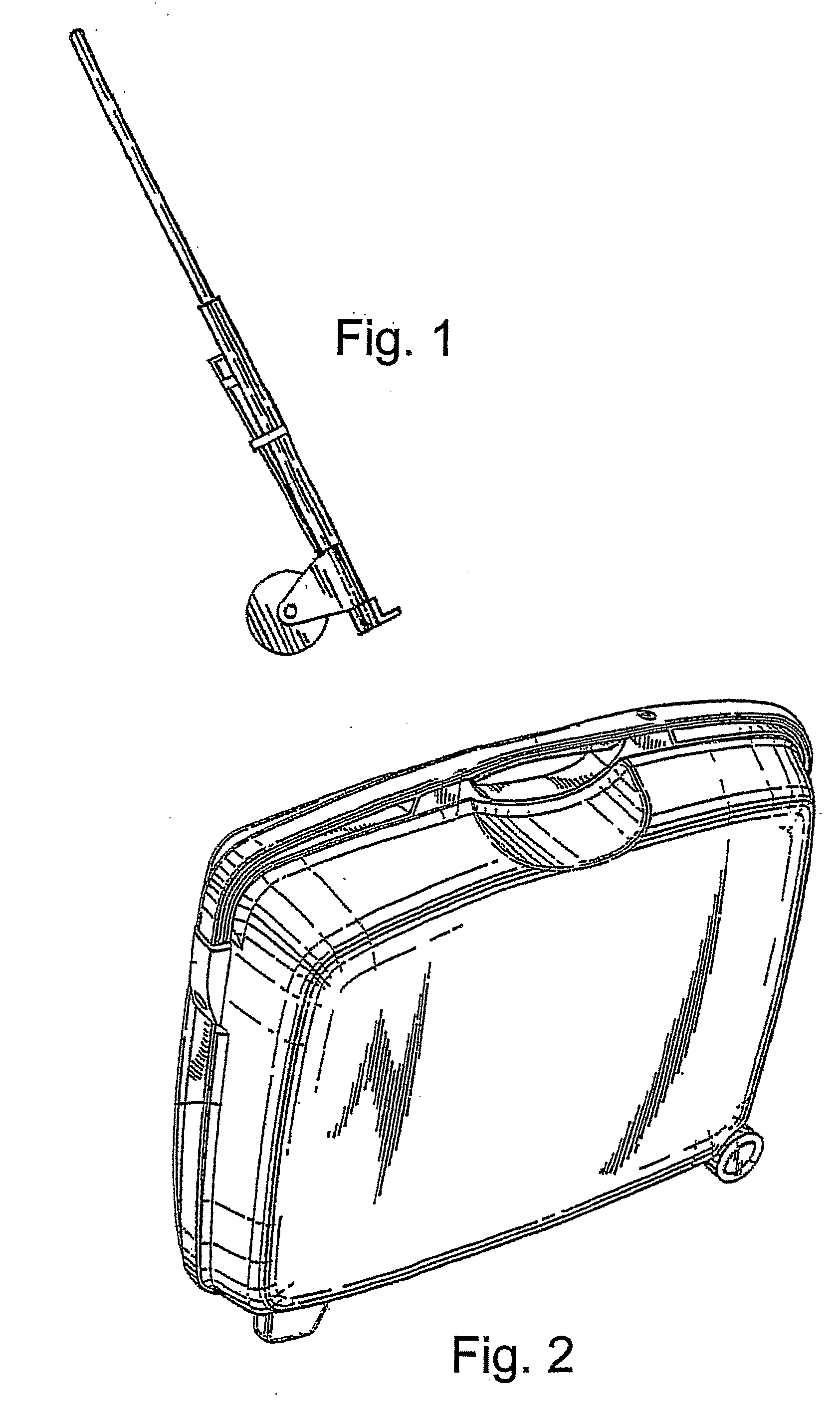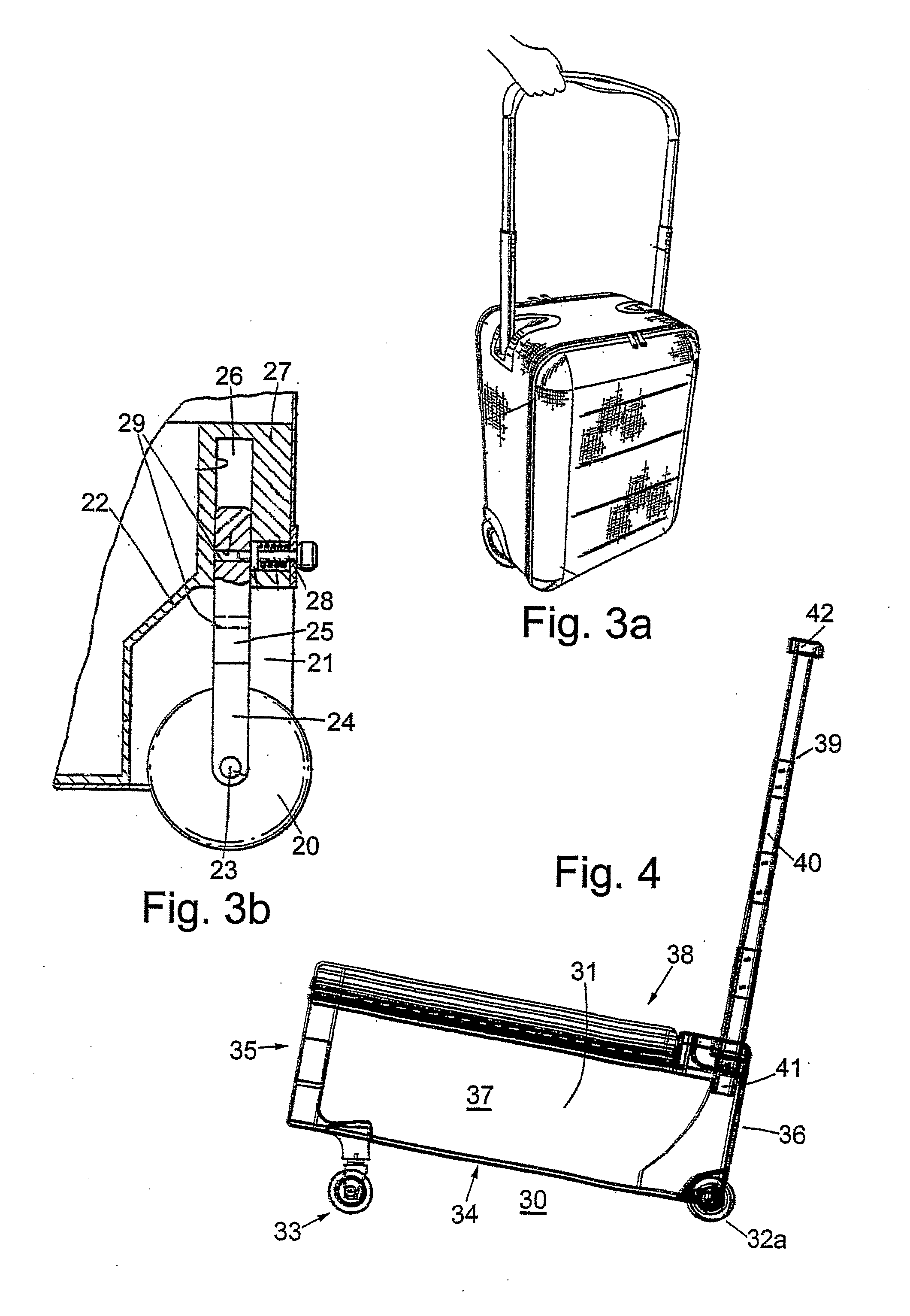Lifting and manually carrying luggage at airports, railway stations, hotels or other sites is a task which is generally disliked by travellers.
Rental luggage carts are available at certain sites of this kind but the
renting process is itself an inconvenience and such carts do not remain with the traveller after leaving the site of rental.
Such carriers are helpful but are not entirely free of inconveniences of their own.
The carrier is not self-stabilized and it is not entirely self-supporting during movement.
The
instability of such a carrier when it is tilted to the travelling orientation and the pivoting movement which occurs when the
handle is released make it unsatisfactory for certain purposes such as for transporting a small child along with a luggage case.
However the significant disadvantages are difficulty in manoeuvrability due to a long narrow base,
instability due to the narrow base and a high centre of gravity that lead to a propensity for the case to topple to one side or the other.
Furthermore, the person pulling such a case generally has to lean over / stoop into an awkward posture to reach the pulling device and generally has inadequate stride clearance in choosing to pull the case behind them.
Lengthening the pulling device is a poor option since it further compromises steerability and stability.
However, widening the base increases the carrying angle and makes hand carrying the case less ergonomic and more laborious.
However, such a design is not self-supporting during transit and requires continuous lifting support from the user to hold it in the in the tilted state.
It is thus good for small and light cases but
large size and / or heavy suitcases with this design are, in wheeled operation, cumbersome and tiresome to move around due to their considerable size and weight.
Indeed, for the elderly and infirm even the smaller and lighter cases with this design may still be a burden and whereas for short transits the burden may be minor, any such burden becomes increasingly irksome the longer the journey, more tiring the environment and more tired the individual is.
Thus though this
cart configuration of wheeled luggage case is relatively more stable in transit and ergonomic than cases with “wheels on long / narrow surface”; relatively manoeuvreable; and easy to activate it suffers from being not self-supporting during transit and may be strenuous with heavy loads and for long journeys and more difficult to use if the user's hand / arm has
arthritis /
deformity or other impairment.
Stride clearance can also be an issue and vibrations can be transmitted to the hand (felt) during case transit on
rough surface (eg. roads).
This configuration of wheeled luggage case also do not facilitate piling up other items on the case (small surface area on top, makes whole luggage heavier because the extra load is placed away from the supporting wheels and towards the carrying hand).
However, it has a high center of gravity and wheels on short / narrow surface, thus is unstable and topples easily on cornering and uneven
terrain.
Again vibrations are transmitted to hand (felt) during case transit on
rough surface (eg. road) and again there is difficulty with piling up other items on the case (small surface area on top).
In all of the previous designs the narrow base and high centre of gravity mean that the cases are unstable.
However, there are practical inconveniences with potential damage to the exposed wheels during transfer and storage and difficulty in packing and unpacking with a non-stationary suitcase.
Also, stacking up of such cases within, for example, the cargo hold of a plane or coach becomes fraught with difficulty again because the cases cannot be relied upon to stay in place.
The multiple retractable wheels of these prior designs are flimsy, cumbersome and inconvenient to activate and retract.
Moreover, they make the whole case too heavy for practical purposes.
Since the weight of the case is concentrated on the pivotal points and / or support pins of the wheel retraction mechanisms, stronger and heavier materials are generally needed to prevent breakdown of the mechanisms, further adding to the overall weight of the case.
In addition, the holding mechanisms are not always able to support the weight of the often heavy luggage for prolonged use which results in failure of the holding mechanism and luggage of this type will often have to be repaired or replaced on a regular basis.
In view of these disadvantages, amongst others, the trolley case arrangement failed to take-off and was quickly abandoned.
However, there is extra weight to the case due to the extra wheel and retraction mechanism and multi-segmented (4 to 5 section) retractable push handle and housing.
The deployment may be relatively tedious for short travelling distances.
 Login to View More
Login to View More  Login to View More
Login to View More 


